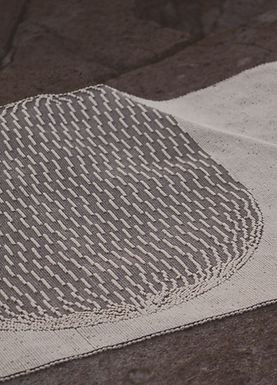
The Pharos project stems from research on lighthouses and maritime lanterns in the Mediterranean, based on architecture, light and communication. These ancient buildings, built in past centuries, contain minimal spaces and perform minimal, but extremely important functions. Each lighthouse has a name recognizable by its light signal and defines a point in the territory: it only takes a few seconds of light to pinpoint its location. Their only function is to communicate their name, which corresponds, sometimes, to their place in the world.
Pharos - rug collection
Designed by Paulina Herrera
X Mariantonia Urru
Ph: Barbara Pau



Tavolara
Capo Testa
Mangiabarche
What caught the artist's attention was the perceived affinity towards these structures: curiosity, that of looking at everything that passes by, the few words. The loneliness. In fact, they are distributed along the coasts, often in uninhabited or isolated places, surrounded by the sea and wild landscapes. They communicate with mariners by repeating their names with pulses of light, according to a specific rhythm, marked on maps by a code that makes them identifiable. The set of lighthouses defines the shape of a territory, with lines and traces made of deeply ephemeral signs. This kind of silent communication is transformed into a code and a pattern. The pattern lights up and disappears, recedes and vanishes. These codes were transformed into a pattern, which was later transferred to the surface of the carpets.

In particular, Tavolara refers to the communication of the Lighthouses of Tavolara Island and Capo Ceraso, both located in the northeastern part of Sardinia, in the vicinity of the port of Olbia. As you approach them, their signals overlap, and this feature of them is reflected in the design of the carpet.
Capo Testa, on the other hand, carries the communication code of the Santa Teresa di Gallura Lighthouse, also in northeastern Sardinia. Specifically, the lighthouse overlooks the Bocche di Bonifacio, an area known to be extremely windy. For this reason, its light code was represented with a graphic distortion shaped by the wind.
Finally, with Mangiabarche, the research moves to the southwestern part of the island, as the model is that of the Mangiabarche Lighthouse in Calasetta. As it faces west, toward the island of San Pietro, the design of the carpet also reports this orientation. Its shape alludes to that of a lantern, a single cylindrical building that is thus recalled by the rounded shape of the pattern.






